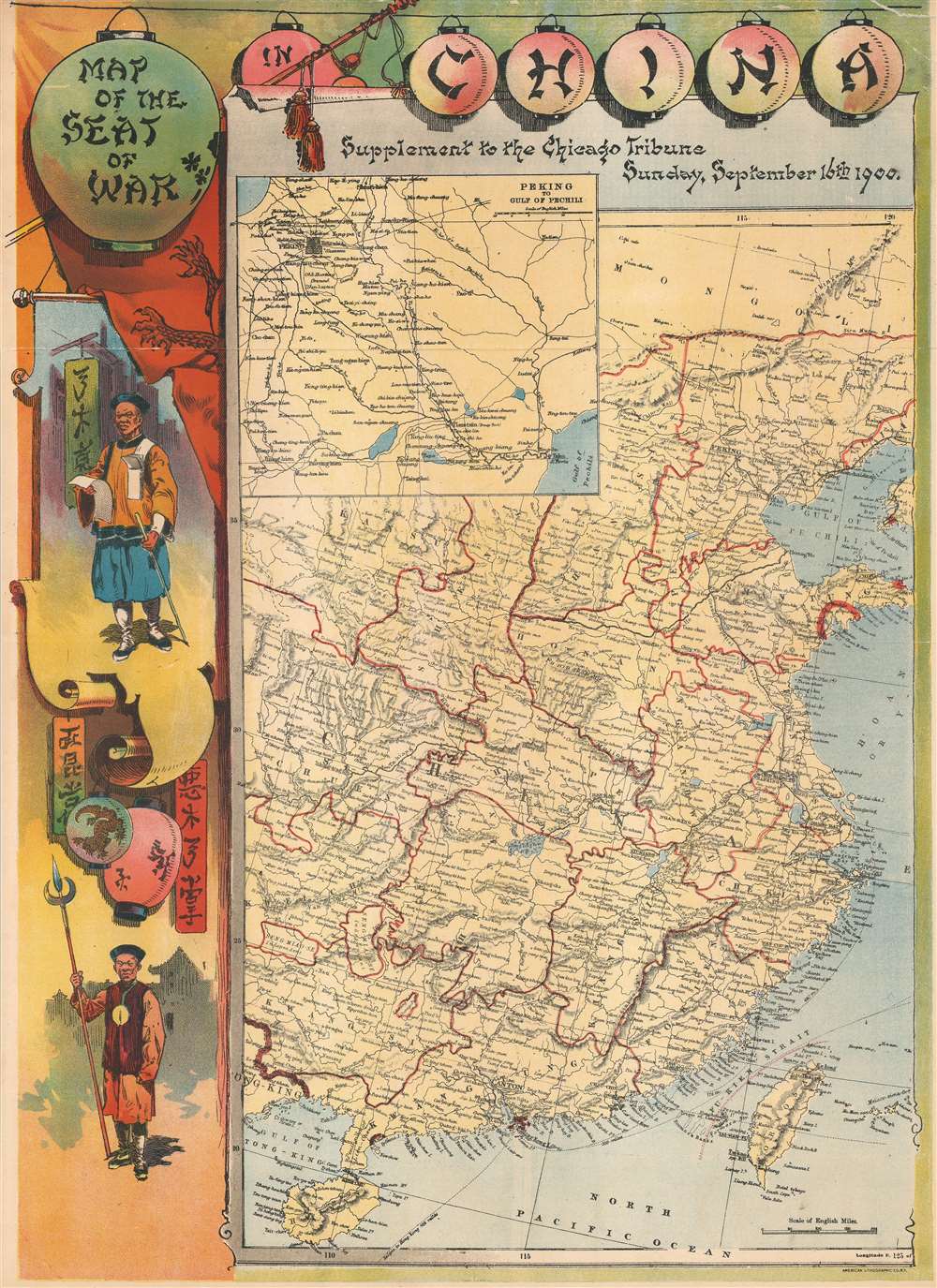This item has been sold, but you can get on the Waitlist to be notified if another example becomes available, or purchase a digital scan.
1900 Chicago Tribune Pictorial Boxer Rebellion Map of China
BoxerRebellionChina2-chicagotribune-1900
Title
1900 (dated) 20 x 14 in (50.8 x 35.56 cm) 1: 1500000
Description
The Boxer Rebellion or Yihetuan Movement
The Boxer Rebellion or Yihetuan Movement was an anti-foreign anti-imperialist uprising marked by proto-nationalism in northeastern China. The rebellion was largely a response to Christian missionary activity in China and was initially supported by the Qing Empress Dowager Cixi. In June of 1900 the quasi-spiritual Boxers, convinced they were immune to foreign weapons, attacked the Chinese Christians and foreign nationals living in Beijing's Legation Quarter. Although many killings ensued the Legation Quarter was able to mount a tenuous defense, as outlined here. Relief came quickly in the form of the Eight-Nation Alliance, which, with an army of some 20,000, defeated the Boxers and occupied Beijing, as well as a number of other northern Chinese cities. The atrocities and looting that ensued, particularly at the hands of Russian and Japanese forces, are well documented and horrifying.Chromolithography
Chromolithography is a color lithographic technique developed in the mid-19th century. The process involved using multiple lithographic stones, one for each color, to yield a rich composite effect. Oftentimes, the process would start with a black basecoat upon which subsequent colors were layered. Some chromolithographs used 30 or more separate lithographic stones to achieve the desired effect. Chromolithograph color could also be effectively blended for even more dramatic effects. The process became extremely popular in the late 19th and early 20th centuries, when it emerged as the dominate method of color printing.Publication History
This map was issued as a supplement to the September 16, 1900 edition of the Chicago Tribune. It was prepared and printed by the American Lithographic Company of New York.Cartographer
The American Lithographic Company (1892 - 1929) was a New York City printing concern active in the late 19th and early 20th centuries. It is considered the first American printing conglomerate. American Lithographic was formed when Joseph Palmer Knapp (1864 - 1951) of the publishing houses Sarony, Major, and Knapp, Major and Knapp, and Knapp and Company, launched a bold plan to consolidate American lithographic printing under one brand. Leveraging his enormous inherited wealth (is father, Joseph Fairchild Knapp (1832 - 1891), was the major shareholder in the Metropolitan Insurance Company), Palmer Knapp consolidated multiple smaller presses, including George S. Harris and Sons, Heppenheimer's and Sons, the Donaldson Brothers Company, the Giles Company, Eddy and Calaus, Witsch and Schmitt, and Schumacher and Ettinger. The consolidation was a hedge to control the lucrative cigar label printing industry. By 1890, prices for color lithography had fallen below sustainable levels due to both the high expense of producing multiple separate stones (one for each color) and favorable manufacturer terms on the purchase of lithographic equipment. This created a highly competitive market, pushing printing prices below cost and driving many smaller companies out of business. By consolidating American lithographic presses under one brand, Knapp hoped to restore industry stability. Initially, the many companies that entered the American Lithographic Company continued to work separately, but by 1900, Knapp centralized production in one large New York City facility. The American Lithographic Company became a major force in American printing, controlling about 75% of the American market for printed graphics. The firm began to decline in the early 20th century when cheaper halftone photographic processes rose to dominate the market. At the same time, demand for fruit and cigar labels, the mainstay of American Lithographic, began to decline. In 1929, the firm was sold to the United States Printing and Lithographic Company, which in 1930 liquidated the cigar label business to Consolidated Lithographing. More by this mapmaker...

